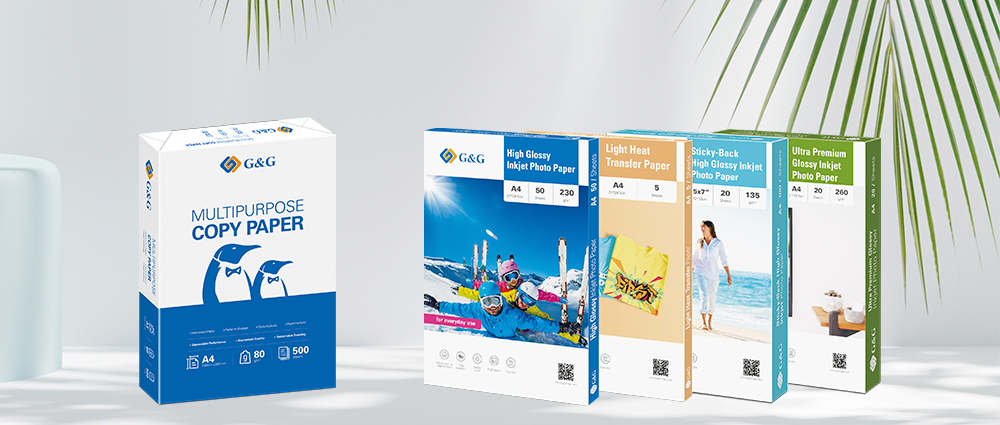-
Consumables
- Printers
- Industries
- Innovation
-
Partners
G&G Partner ProgramCo-Innovating Tomorrow Read More >
- About Us
-
Contact Us

For any printing project—whether it's documents, photos, or creative projects—the first thing to think about is always the paper type you'll use. The right printer paper makes a huge difference in how your prints turn out. To help you choose the best printing paper for your needs, let's break it down into some simple, easy-to-understand points.
First things first: think about what size you need. The most common size is Letter (8.5" x 11"), which is used for standard documents and most everyday printing. If you're outside the U.S., you'll probably use A4 (8.27" x 11.69"). Here are the other main paper sizes:
Paper | Dimensions | Dimensions | Use |
A3 | 11.7*16.5 | 297*420 | Drawings, posters, presentations |
A4 | 8.3*11.7 | 210*297 | Documents, flyers, brochure, reports |
A5 | 5.8*8.3 | 148*210 | Flyers, notepads, booklets |
B2 | 19.7*27.8 | 500*707 | Large posters, calendars, presentations |
B3 | 13.9*19.7 | 353*500 | large charts, graphs, folded posters |
C6 | 4.5*6.4 | 114*162 | Envelops for an A4 letter folded twice |
Letter | 8.5*11 | 216*279 | Business documents, letters, and schoolwork |
Legal | 8.5*14 | 216*356 | Legal documents, contracts |
Tabloid | 11*17 | 279*432 | Newspapers, magazines, brochures, posters |
Arch C | 18*24 | 457*610 | Architecture drawings |
Paper weight measures how thick and sturdy the paper is. You'll see this measured in pounds (lb) or grams per square meter (gsm). Thicker paper feels more professional and handles ink better, but make sure your printer can handle the weight. Paper that is too thick for your printer may get stuck in your printer, causing a paper jam or even damaging the inner components.
20 lb (75 gsm): Standard weight for everyday printing and copying. It's lightweight and suitable for general use.
24 lb (90 gsm): Slightly thicker and more opaque, ideal for double-sided printing and important documents.
32 lb (120 gsm): Heavier and perfect for presentations and high-quality prints.
Cardstock (60-100 lb / 160-270 gsm): Very thick and durable, ideal for business cards, postcards, menus, and invitations.
Brightness is another key factor. It refers to how much light the paper reflects, which affects contrast and clarity of your prints. The scale goes from 1 to 100, with higher numbers meaning brighter paper. For everyday use, 80-90 brightness is fine. For photos or professional prints, go for 90-100. Brighter paper makes colors pop and text sharp, making your prints look their best.
The finish of the paper affects its texture and how it interacts with ink. Here are the main types:
Matte: Smooth and non-reflective, perfect for text-heavy documents. Matte paper reduces glare and is easy to read.
Glossy: Shiny and vibrant, great for printing photos and marketing materials. Glossy paper makes colors look more vibrant and eye-catching.
Semi-gloss (Satin): Offers a balance between matte and glossy, giving you vibrant colors without too much glare.
Textured: Adds a tactile feel, suitable for invitations, greeting cards, and artistic prints.
While white is the most common paper color, colored paper is also great for specific uses. Light colors like pastel blue, pink, or yellow can make your flyers or announcements stand out. Just make sure the color doesn’t make your text hard to read.
For those who are environmentally conscious, there are plenty of eco-friendly paper. Look for paper with FSC (Forest Stewardship Council) or SFI (Sustainable Forestry Initiative) certifications, which means it comes from responsibly managed forests.
Recycled paper is another great choice, often made from 100% post-consumer waste and reducing the need for new raw materials. It's good for the environment and still gives you great print quality.
Finally, think about the type of paper you need for your specific task. Here are some common types:
Explore G&G's wide range of paper products. From copy paper and photo paper to thermal paper and sticker paper, we have options in various sizes to meet all your printing needs. Whatever your project, we have the perfect paper to give you high-quality results every time.







